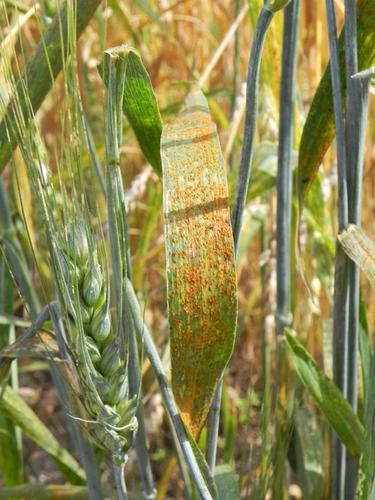当前位置:
X-MOL 学术
›
Plant Pathol.
›
论文详情
Our official English website, www.x-mol.net, welcomes your feedback! (Note: you will need to create a separate account there.)
Regional and temporal differentiation of virulence phenotypes of Puccinia triticina Eriks. from common wheat in Russia during the period 2001‐2018
Plant Pathology ( IF 2.7 ) Pub Date : 2020-03-24 , DOI: 10.1111/ppa.13174 Elena I. Gultyaeva 1 , Ekaterina L. Shaydayuk 1 , Evsey G. Kosman 2
Plant Pathology ( IF 2.7 ) Pub Date : 2020-03-24 , DOI: 10.1111/ppa.13174 Elena I. Gultyaeva 1 , Ekaterina L. Shaydayuk 1 , Evsey G. Kosman 2
Affiliation

|
Leaf rust, caused by the fungus Puccinia triticina, is one of the most damaging rust diseases of wheat in Russia. Populations of P. triticina were monitored in seven regions of Russia from 2001 to 2018, with a total of 5,191 single urediniospore isolates from bread wheat (Triticum aestivum) being analysed. Populations have changed significantly in all regions since 2012, after 2 years of drought (2010–2011). Regional collections of P. triticina were also significantly different between the two periods 2001–2009 and 2012–2018, with changes along two geographic gradients from West Siberia to the north‐west and south‐west (North Caucasia) of the European part of Russia. All tested isolates were avirulent to resistance gene Lr9 in 2001–2009 but, since 2010, virulence to Lr9 has occurred and annually increased in the Asian part of Russia (Ural and West Siberia) due to deployment of cultivars with the Lr9 gene. Virulence to Lr2a and Lr15 was considerably lower in Dagestan (6%–33%) and all European regions (35%–67%) than in Asian regions (84%–96%). During 2001–2009, virulence on Lr1 was also lower in Dagestan (33%) and the European regions (50%–77%) than in Asia (91%–96%); however, by 2012–2018, nearly all isolates were virulent on Lr1. Remarkable changes were observed in frequencies of P. triticina races defined by their virulence/avirulence to Lr1 and Lr2a genes. We postulate the P. triticina population in Dagestan is specific to that area and pathogen populations in European and Asian parts of Russia are distinct.
中文翻译:

Puccinia triticina Eriks 毒力表型的区域和时间分化。2001-2018 年期间俄罗斯普通小麦
由真菌 Puccinia triticina 引起的叶锈病是俄罗斯最具破坏性的小麦锈病之一。从 2001 年到 2018 年,在俄罗斯的七个地区监测了 P. triticina 种群,分析了来自面包小麦 (Triticum aestivum) 的 5,191 个单一的小麦孢子分离株。在经历了 2 年的干旱(2010-2011 年)之后,自 2012 年以来,所有地区的人口发生了显着变化。P. triticina 的区域收集在 2001-2009 和 2012-2018 两个时期也有显着差异,沿两个地理梯度变化,从西西伯利亚到俄罗斯欧洲部分的西北部和西南部(北高加索) . 2001-2009 年所有测试的分离株对抗性基因 Lr9 无毒,但自 2010 年以来,由于部署了带有 Lr9 基因的栽培品种,对 Lr9 的毒力在俄罗斯的亚洲部分(乌拉尔和西西伯利亚)已经发生并且每年都在增加。达吉斯坦 (6%–33%) 和所有欧洲地区 (35%–67%) 对 Lr2a 和 Lr15 的毒力远低于亚洲地区 (84%–96%)。2001-2009 年,Lr1 的毒力在达吉斯坦 (33%) 和欧洲地区 (50%-77%) 也低于亚洲 (91%-96%);然而,到 2012-2018 年,几乎所有分离株都对 Lr1 具有毒性。在由对 Lr1 和 Lr2a 基因的毒力/无毒力定义的 P. triticina 小种的频率中观察到显着变化。我们假设达吉斯坦的 P. triticina 种群是该地区特有的,而俄罗斯欧洲和亚洲部分的病原体种群是不同的。达吉斯坦 (6%–33%) 和所有欧洲地区 (35%–67%) 对 Lr2a 和 Lr15 的毒力远低于亚洲地区 (84%–96%)。2001-2009 年,Lr1 的毒力在达吉斯坦 (33%) 和欧洲地区 (50%-77%) 也低于亚洲 (91%-96%);然而,到 2012-2018 年,几乎所有分离株都对 Lr1 具有毒性。在由对 Lr1 和 Lr2a 基因的毒力/无毒力定义的 P. triticina 小种的频率中观察到显着变化。我们假设达吉斯坦的 P. triticina 种群是该地区特有的,而俄罗斯欧洲和亚洲部分的病原体种群是不同的。达吉斯坦 (6%–33%) 和所有欧洲地区 (35%–67%) 对 Lr2a 和 Lr15 的毒力远低于亚洲地区 (84%–96%)。2001-2009 年,Lr1 的毒力在达吉斯坦 (33%) 和欧洲地区 (50%-77%) 也低于亚洲 (91%-96%);然而,到 2012-2018 年,几乎所有分离株都对 Lr1 具有毒性。在由对 Lr1 和 Lr2a 基因的毒力/无毒力定义的 P. triticina 小种的频率中观察到显着变化。我们假设达吉斯坦的 P. triticina 种群是该地区特有的,而俄罗斯欧洲和亚洲部分的病原体种群是不同的。然而,到 2012-2018 年,几乎所有分离株都对 Lr1 具有毒性。在由对 Lr1 和 Lr2a 基因的毒力/无毒力定义的 P. triticina 小种的频率中观察到显着变化。我们假设达吉斯坦的 P. triticina 种群是该地区特有的,而俄罗斯欧洲和亚洲部分的病原体种群是不同的。然而,到 2012-2018 年,几乎所有分离株都对 Lr1 具有毒性。在由对 Lr1 和 Lr2a 基因的毒力/无毒力定义的 P. triticina 小种的频率中观察到显着变化。我们假设达吉斯坦的 P. triticina 种群是该地区特有的,而俄罗斯欧洲和亚洲部分的病原体种群是不同的。
更新日期:2020-03-24
中文翻译:

Puccinia triticina Eriks 毒力表型的区域和时间分化。2001-2018 年期间俄罗斯普通小麦
由真菌 Puccinia triticina 引起的叶锈病是俄罗斯最具破坏性的小麦锈病之一。从 2001 年到 2018 年,在俄罗斯的七个地区监测了 P. triticina 种群,分析了来自面包小麦 (Triticum aestivum) 的 5,191 个单一的小麦孢子分离株。在经历了 2 年的干旱(2010-2011 年)之后,自 2012 年以来,所有地区的人口发生了显着变化。P. triticina 的区域收集在 2001-2009 和 2012-2018 两个时期也有显着差异,沿两个地理梯度变化,从西西伯利亚到俄罗斯欧洲部分的西北部和西南部(北高加索) . 2001-2009 年所有测试的分离株对抗性基因 Lr9 无毒,但自 2010 年以来,由于部署了带有 Lr9 基因的栽培品种,对 Lr9 的毒力在俄罗斯的亚洲部分(乌拉尔和西西伯利亚)已经发生并且每年都在增加。达吉斯坦 (6%–33%) 和所有欧洲地区 (35%–67%) 对 Lr2a 和 Lr15 的毒力远低于亚洲地区 (84%–96%)。2001-2009 年,Lr1 的毒力在达吉斯坦 (33%) 和欧洲地区 (50%-77%) 也低于亚洲 (91%-96%);然而,到 2012-2018 年,几乎所有分离株都对 Lr1 具有毒性。在由对 Lr1 和 Lr2a 基因的毒力/无毒力定义的 P. triticina 小种的频率中观察到显着变化。我们假设达吉斯坦的 P. triticina 种群是该地区特有的,而俄罗斯欧洲和亚洲部分的病原体种群是不同的。达吉斯坦 (6%–33%) 和所有欧洲地区 (35%–67%) 对 Lr2a 和 Lr15 的毒力远低于亚洲地区 (84%–96%)。2001-2009 年,Lr1 的毒力在达吉斯坦 (33%) 和欧洲地区 (50%-77%) 也低于亚洲 (91%-96%);然而,到 2012-2018 年,几乎所有分离株都对 Lr1 具有毒性。在由对 Lr1 和 Lr2a 基因的毒力/无毒力定义的 P. triticina 小种的频率中观察到显着变化。我们假设达吉斯坦的 P. triticina 种群是该地区特有的,而俄罗斯欧洲和亚洲部分的病原体种群是不同的。达吉斯坦 (6%–33%) 和所有欧洲地区 (35%–67%) 对 Lr2a 和 Lr15 的毒力远低于亚洲地区 (84%–96%)。2001-2009 年,Lr1 的毒力在达吉斯坦 (33%) 和欧洲地区 (50%-77%) 也低于亚洲 (91%-96%);然而,到 2012-2018 年,几乎所有分离株都对 Lr1 具有毒性。在由对 Lr1 和 Lr2a 基因的毒力/无毒力定义的 P. triticina 小种的频率中观察到显着变化。我们假设达吉斯坦的 P. triticina 种群是该地区特有的,而俄罗斯欧洲和亚洲部分的病原体种群是不同的。然而,到 2012-2018 年,几乎所有分离株都对 Lr1 具有毒性。在由对 Lr1 和 Lr2a 基因的毒力/无毒力定义的 P. triticina 小种的频率中观察到显着变化。我们假设达吉斯坦的 P. triticina 种群是该地区特有的,而俄罗斯欧洲和亚洲部分的病原体种群是不同的。然而,到 2012-2018 年,几乎所有分离株都对 Lr1 具有毒性。在由对 Lr1 和 Lr2a 基因的毒力/无毒力定义的 P. triticina 小种的频率中观察到显着变化。我们假设达吉斯坦的 P. triticina 种群是该地区特有的,而俄罗斯欧洲和亚洲部分的病原体种群是不同的。


























 京公网安备 11010802027423号
京公网安备 11010802027423号